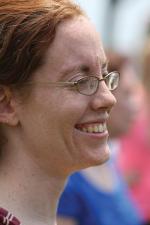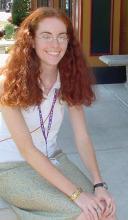Supporting Science
Fall
2013
Special Feature
Supporting Science
From Science Research to Science Journalism: How an Internship Sparked my Career Transition
By:Katie Peek, 2002 SPS intern, currently an information graphics editor at Popular Science magazine
 Sometimes the most powerful realizations are the slowest to materialize. It took me years—and writing this essay—to realize what I really learned at my SPS internship in the summer of 2002. I had just graduated from Mount Holyoke College, and it was my third time with a summer gig. I would spend the summer at NASA Goddard Space Flight Center in Greenbelt, MD, researching if there was enough dust near the Sun to damage a spacecraft.
Sometimes the most powerful realizations are the slowest to materialize. It took me years—and writing this essay—to realize what I really learned at my SPS internship in the summer of 2002. I had just graduated from Mount Holyoke College, and it was my third time with a summer gig. I would spend the summer at NASA Goddard Space Flight Center in Greenbelt, MD, researching if there was enough dust near the Sun to damage a spacecraft.
I knew what I was supposed to get out of the internship: some research expertise, some new connections, and a line on my CV. And I got those things, for sure. But I also started down a path that eventually led me away from astronomy research altogether.
Two summers earlier, I had worked at Cornell University in Ithaca, NY, through the Research Experiences for Undergraduates (REU) program. The Cassini mission was scheduled to reach Saturn in four years. Working with a ring-system expert, I used a simulation of Cassini’s path around Saturn to flag interesting geometries, angles, and perspectives that the team might want to know about in advance of the spacecraft’s arrival.
I used the foundation I built at Cornell the next summer when I worked at the Lunar and Planetary Institute in Houston, TX. There, my adviser and I put together a numerical simulation of Saturn’s ring system. To test the hypothesis that the rings formed after the breakup of a moon, we simulated whether a dense, narrow ring of material could dissipate into a ring system. (The answer was an unsatisfying “maybe.”)
For a student at a small liberal arts college, these two internships were windows into big research-heavy astronomy departments. The experiences made me want to become a big research-heavy astronomer. So I got a PhD at the University of California, Berkeley, to do just that.
But I’m not a working as a research astronomer today. I create the information graphics at Popular Science magazine. That transition was slow—it involved a lot of soul-searching and a second degree in science journalism from New York University—but the germ of it came from my third internship. At SPS.
Unlike the interns I had met during my previous summers, SPS interns took communication just as seriously as research. Two interns spent the summer designing kits for SPS chapters to use in their outreach programs. One was my roommate, Lauren Glas (now Lauren Zarandona). She was totally dedicated to physics teaching and science policy. I had done a bit of outreach with my SPS chapter, but I found her passion impressive.
We were particularly inspired by a trip we made to Capitol Hill to visit a science subcommittee meeting. I don’t remember what the topic was, or even if the event took place in the House or the Senate, but I do remember the two of us on the bus back to our dorm, discussing just how much work it takes to make science possible. That chamber was crowded with people who, for the most part, weren’t scientists. But they worked passionately to create a home for science in the United States.
to make science possible. That chamber was crowded with people who, for the most part, weren’t scientists. But they worked passionately to create a home for science in the United States.
I like to think that today I help create a home for science by making data beautiful and engaging. It only took me most of a decade to make that summer's realization my reality. //
Graphically Speaking
Katie Peek designed the info graphic shown below for Popular Science magazine - view more of her work on her portfolio website: http://portfolio.katiepeek.com.

